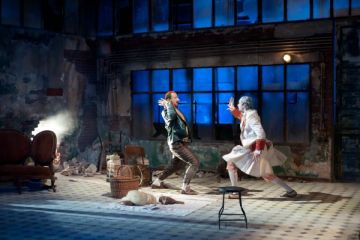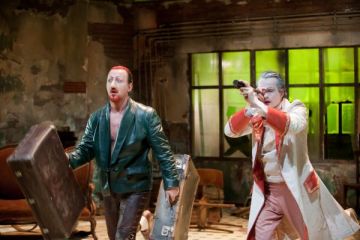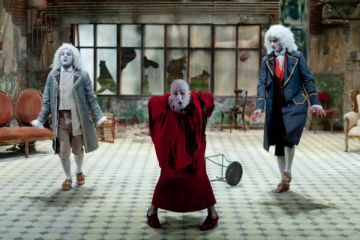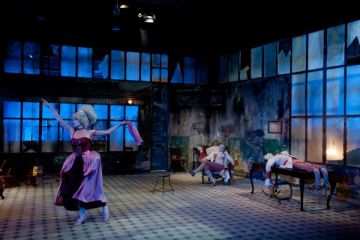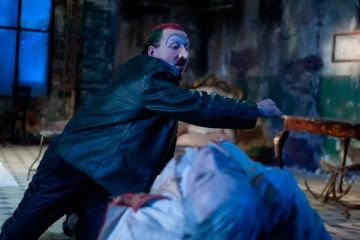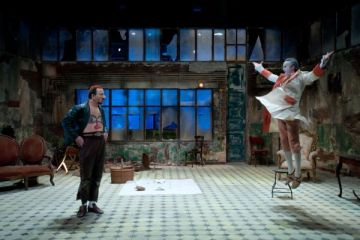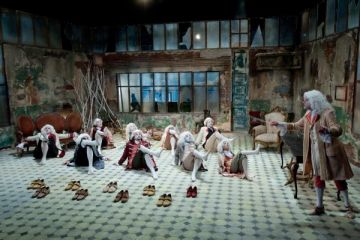Studio Performance in the Main Hall
1h 40' without intermission
Tompa’s production is bitterly gibing. It tells us in a mockingly ironical way that we have been marking time for a good while, but we create an ideology of renewal out of this impossible stagnation, sometimes we even call it a revolution. Carmencita Brojboiu, the costume designer dressed the actors in period dresses and powdered wigs, but she created a setting reminding us of a deserted factory building. She made this world grotesque and strongly inconsistent. The madness of power is concealed by over-embellishment, and we realize that the performance wants to deal with questions of current concern. Without deliberately converting the play into present reality Tompa – being interested in aesthetics – speaks far too about the present.
Tompa’s opening performance is an extremely comical rediscovery of Georg Büchner’s satire, Leonce and Lena written in 1836. The spectacle of the play is consistently fascinating (the set and costume designer is Carmencita Brojboiu). We can say of Büchner that he discovered naturalism and expressionism by Woyzeck and it seems that he discovered the absurd theatre as well with Leonce and Lena. Tompa’s production – similar to The Bald Primadonna production – is a charming mixture of political idiotism and absurd insolence.
Robert Cohen, Plays International
Gábor Tompa – as he highlights it in the theatre programme of the play - avoids commenting political problems directly. He has recourse to art theatre, and calls our attention in a subtle, symbolic way to the negative aspects of the Romanian society: stagnation, marking time. In a self-mocking way he tries to find solution in the theatre, so the end of the performance becomes an escape to the theatre within the theatre. "Let’s build a theatre", sings the royal court in the last song of the performance. The theatre that needs to reinterpret itself – since it functions in a world that has to be criticized - is filled with disappointment too. Reinterpretation is possible only if theatre finds in himself the necessary energy to do that and does not become the imitation of his own legendary past.
Cristina Modreanu: Leonce şi Lena postrevoluţie... [Leonce and Lena" postrevolution...], ArtAct Magazine, December 15, 2010
Leonce and Lena is a nice performance. It is a beautiful story for adults full of humor, irony, piquancy, picturesque images. The ball of the narration mixes perfectly the threads of the "world’s great theatres", thus becoming a noteworthy post-modern conglomerate. The play offers the audience the memorable experience of an excellent performance full of laughter, excitement, ironical estrangement, childlike empathy, pure joy and rational reasoning. We are witnesses to a meeting between a genial author and an extremely delicate interpreter. One has to go and see Leonce and Lena. Having said this I think I have said all.
Claudiu Groza: Teatrul cel mare al lumii [The great theater of the world], Tribuna, January 16, 2011
Gábor Tompa’s production creates a fairy play where light is heavy and vice versa, the weighty is feather-weight. By doing this he places Büchner’s play on the axis of the history of theatre (starting from Shakespeare until the present time) suggesting that the short-lived German poet is not just the successor of the great Englishman, but he is the predecessor of Beckett and Ionesco too. Büchner’s text is as obliviously playful as A Midsummer Night’s Dream, but at the same time it is as unsettling in his questions and emphasis as his descendants from the 20th century. This is the reason for so much graceful dance, well-composed body-play, oblivious impishness and funny visual action. This is the reason for the often vulgar words and gestures, overtones of meaninglessness and senselessness. The two registers go hand in hand all along the play like the spectacle of understanding and experience reflecting grains of truth in falsehood and grains of falsehood in truth. The "original" Büchner might be ironical, however the play’s adaptation moves into the direction of the absurd, thus it brings the play closer to our world. The culture of contemporary theatre is at home in it, but the sensitivity of an audience watching movies and television is also mobilized: the play challenges our consciousness fighting with the world of appearances.
Gábor Tompa’s production offers the spectator more and more exciting ideas, language and visual games in every minute, he is very particular about entertaining the audience all the time. Leonce and Lena functions with the exactness of a Swiss watch but remains light as a feather all along.
Büchner’s "profoundly philosophical burlesque", parody-like fairy tale directed by Gábor Tompa gets a realist-surrealist register. It’s enough if we mention the Romanian inscription about labor safety and fire protection on the walls of the deserted factory building, the broken windows and walls – lots of places like this all over the country. Living in such spaces we are haunted by Büchner’s figures. The characters conjuring up the age of rococo dream of life, freedom, love, country leader and subject behavior. In vain. When the surreal dream ends, the actors find themselves in the same place: in the ruinous, crumbling empty space where only labor and fire regulations from the past hold good. You cannot build on such a thing. Not even a theatre.
In Gábor Tompa’s production the comical, burlesque register is succeeded by a mournful tone at the end of the play ... the performance emphasizes Büchner’s clear-sightedness. He foretold the world’s turning inside out, the alienation of the individual examined later on by absurd literature.
National Theatre Festival, Pécs, Hungary (2011)
National Theatre Festival (FNT), Bucharest (2011)
MESS Theatre Festival, Sarajevo, Bosnia and Herzegovina (2011)
13th edition of the Iberoamericano Theatre Festival of Bogotá, Columbia (2012)
National Theatre of Prague, Czeh Republic (2013)
Büchner International Theatre Festival, Giessen, Germany (2013)
Date of the opening: december 02, 2010
Both Leonce and Lena flee from home to avoid a wedding planned by others. However, they inevitably fall in love with each other. Leonce and Lena is a comedy written at a time when Germany was made up of eighty little states, and it is the first masterpiece in the history of drama to present the mechanism that depersonalizes and detaches thought and speech. The characters play with their death-machine toys and, like naughty children, break them in order to find their individual freedom.
Gábor Tompa



















